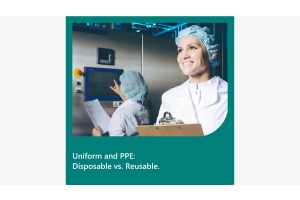Uniform and PPE: Disposable vs. Reusable.

In the food industry, choosing between disposable and reusable uniforms and personal protective equipment (PPE) is a decision that impacts hygiene, safety, cost, environmental sustainability, and operational efficiency. This blog explores the pros and cons of both options, providing insights into making the best choice for your business.
1. The Role of Uniforms and PPE in the Food Industry
Uniforms and PPE are crucial for:
Protection: Safeguarding workers from contamination and potential hazards such as sharp objects or chemical exposure.
Hygiene: Preventing contamination of food products by acting as a barrier between the worker and the food.
Identification: Distinguishing staff members and their roles within the organization.
Compliance: Meeting health and safety regulations to maintain industry standards.
Selecting the right type of uniform and PPE is essential for ensuring these functions are effectively met.
2. Disposable PPE
Advantages
Hygiene and Safety: Disposable items are used once and then discarded, significantly reducing the risk of cross-contamination and ensuring a consistently high level of hygiene.
Convenience: Eliminates the need for laundering, saving time and reducing logistical challenges in maintaining a clean inventory.
Compliance: Simplifies adherence to health and safety standards, as disposables are typically designed to meet specific regulatory requirements.
Colour Coding: Easily implementable colour coding aids in staff role distinction, making large items like lab coats easily identifiable.
Fresh Appearance: Always new and unstained, offering a consistently clean and professional look.
Disadvantages
Material Quality: Often less comfortable and durable than reusable options, potentially affecting worker comfort and productivity.
Comfort: Generally, not as well-fitted or comfortable, as they are made to be economical.
Stock Management: Ensuring sufficient stock is available for each shift and avoiding shortages, Finding a reliable supplier will help mitigate this.
3. Reusable Uniforms
Advantages
Quality and Comfort: They are typically made from higher-quality materials, providing better comfort and protection, which can enhance employee satisfaction and productivity.
Conformity: Ensures uniformity in staff attire, supports food safety, and prevents unsuitable garments from entering production areas.
Disadvantages
Hygiene Management: Maintaining cleanliness requires a reliable laundering system. Inadequate washing can lead to contamination risks.
Logistics: Managing inventory, collection, laundering, and distribution can be complex and resource-intensive, often considered hidden costs.
Wear and Tear: Over time, reusable items may deteriorate, necessitating proper maintenance and timely replacement to avoid hygiene issues.
Availability: Delays in laundry services can disrupt operations. However, having emergency disposable wear on hand can offset this risk.
Staff Turnover: High staff turnover can complicate size management, making it challenging to ensure the correct sizes are always available.
4. Making the Right Choice
Choosing between disposable and reusable uniforms and PPE in the food industry depends on several factors:
Scale of Operation: Smaller businesses may find disposables more convenient, while larger operations might benefit from the long-term cost savings of reusables.
Regulatory Requirements: Some regulations may dictate the use of specific PPE or uniforms, influencing the choice or necessitating a combination of both.
Environmental Policies: Consider the full life cycle of garments, including replacement frequency, landfill impact, and material sustainability. Reusable items, while potentially more environmentally friendly, may occupy more landfill space when disposed of due to their bulkier material.
Budget Considerations: A thorough cost analysis, including hidden costs such as logistics and laundering, is crucial to determine the most cost-effective option. Comparing the cost per use of reusables with the one-time cost of disposables helps in making an informed decision.
5. Conclusion
Selecting the appropriate uniforms and PPE in the food industry involves balancing various factors. While food safety remains the top priority, considerations of sustainability and cost are increasingly important. A thorough analysis is necessary to avoid hidden costs and ensure the best decision-making, aligning with both business objectives and regulatory requirements.








